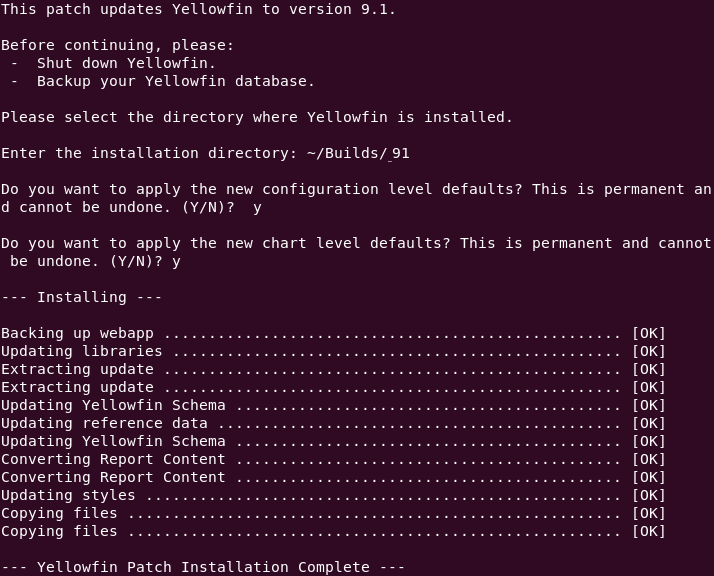Page History
| Anchor | ||||
|---|---|---|---|---|
|
| Table of Contents | ||
|---|---|---|
|
Overview
| Styleclass | ||
|---|---|---|
| ||
All text and images in the Yellowfin patch installer are customisable in the same way as the main installer, using a custom properties file, or by command-line arguments. The patch installer does not require many options, as these are all read from the Yellowfin installation’s configuration files.
...
Argument | Value |
|---|---|
| The Yellowfin Installation Directory |
Available Properties
Tip: If a silent installation update is unsuccessful, you will be able to find errors written into the upgrade log.
Available Properties
| Styleclass | ||
|---|---|---|
| ||
...
| Expand | |||||||
|---|---|---|---|---|---|---|---|
| |||||||
These properties change the behaviour of the installer.
See below for further information. |
| Anchor | ||||
|---|---|---|---|---|
|
Updating a Specific Component
You can use the Silent updater to upgrade a specific component of Yellowfin, that is the filesystem or the configuration database, or both.
For instance, upgrading the database:
java -jar update.jar -silent "YFPath" option.upgrade=databaseWhere, option.upgrade specifies the component to be upgraded. You can use the keyword ‘filesystem’ to update the Yellowfin file system.
This requires specifying the Yellowfin file path to point to the database. Since this information is extracted from the file system (specifically the web.xml file), this method is dependent on the file system.
Independent component upgrade
The following examples demonstrate how to independently update a Yellowfin component. This means when upgrading the database, you will not need to specify the file path.
Condition 1: Independent upgrade of only the database. Requires passing additional parameters, such as jdbcUser, jdbcPassword and jdbcURL. The jdbcURL specified here will let the updater know the database type.
Example:
java -jar yellowfin-20180402-update.jar -silent option.upgrade=database jdbcUser=yellowfin jdbcPassword=password jdbcURL=jdbc:mysql://localhost:3306/yellowfin_74_masterWhere,
option.upgrade - set this to the keyword ‘database’ to update the configuration database, or ‘filesystem’ to update Yellowfin files. For example, option.update=database.
jdbcUser - username to connect to the Yellowfin configuration database (not required when updating the file system.)
jdbcPassword - the password to the above (should not be encrypted)
jdbcURL - the JDBC connection URL. Lets the system know specific database details, such as its type and name, server URL, connection port. (Tip: if you do not know this, you can manually retrieve this from the web.xml file from your Yellowfin folder.)
Condition 2: If you want to use a different driver class, or if the jdbcURL is not recognised by the updater, then an additional jdbcDriver parameter must be passed.
For example,
java -jar yellowfin-20180402-update.jar -silent option.upgrade=database jdbcUser=yellowfin jdbcPassword=password jdbcURL=jdbc:mysql://localhost:3306/yellowfin_74_master jdbcDriver=com.mysql.jdbc.Driverwhere,jdbcDriver - specifies the canonical class name for the JDBC Driver.
Condition 3: You want to use a different driver to connect to the database, or provide your own jar file. This requires passing the driver to be used, in conjunction with the other parameters. Ensure that the driver you upload belongs to a database supported by Yellowfin. Note that you will not be able to use the java -jar classpath.
Example:
java -cp mysql-connector-java-5.1.25-bin.jar:yellowfin-20180402-update.jar com.hof.patch.PatchInstaller -silent option.upgrade=database jdbcUser=yellowfin jdbcPassword=password jdbcURL=jdbc:mysql://localhost:3306/yellowfin_74_master jdbcDriver=com.mysql.jdbc.Driver
...
Chart and Configuration Defaults
Yellowfin 9 has Chart and Report defaults for colors, fonts, styles, padding and other types of visual formatting. These settings impact the default look and feel of your charts and reports without requiring much effort to further customize them. These settings can be enabled while upgrading. See below for description.
- Configuration level defaults: These are color, fonts and style defaults for reports and charts. Administrators are manually able to update these via the Admin Console Content settings.
- Chart defaults: These are default chart formats set up in the Chart builder. This includes settings such as chart axes, legends, sorting, padding, and other visual elements.
Silent Installer Options
The following options can be used for these settings while upgrading with the Silent Installer.
Setting | Option | Value |
|---|---|---|
Configuration level defaults | option.migrate9Configuration | Applies the new chart and report formatting defaults controlled at the Configuration level, introduced in Yellowfin 9. These are color, fonts and style defaults for reports and charts. Set this option to true if you want all the new configuration defaults to be applied to your instance. If you don't set this option at all, it defaults to false. |
| Chart defaults: | option.migrate9ChartDefaults | These are default chart formats set up in the Chart builder, introduced in Yellowfin 9. This includes settings such as chart axes, legends, sorting, padding, and other visual elements. Set this option to true if you want all your charts to take the new chart default formatting. If you don't set this option at all, it defaults to false. |
Command Line Options
In the Command line installer, the user is prompted for each option individually with a yes/no response. Shown in the example screenshot below.
| horizontalrule |
|---|
| Styleclass | ||
|---|---|---|
| ||
...
